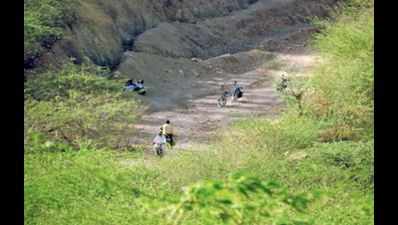- News
- City News
- jaipur News
- How Bundi's own 'mountain man' bent a hill to his will
Trending
This story is from September 6, 2016
How Bundi's own 'mountain man' bent a hill to his will
Like Dashrath Manjhi, Baba Bajrang Das Dug A Track Across The Indergarh Range To Connect 40 Villages With Their Tehsil Town

Like Dashrath Manjhi, Baba Bajrang Das Dug A Track Across The Indergarh Range To Connect 40 Villages With Their Tehsil Town
Two years after Bihar's 'mountainman' Dashrath Manjhi laid down his hammer and chisel, having cleaved a road out of the rock that claimed his wife's life, the hills around Gendoli in Bundi district of Rajasthan started echoing with the sound of steel striking stone. Baba Bajrang Das of the local Mandpur Matth had decided to bring villages separated by the Indergarh hill range closer.
Gendoli, about 40km from Bundi, is a tehsil town and important market for the inhabitants of the 40-odd villages that lie across the range."They came to sell milk and 'mawa' in Gendoli and Bundi.Most of them were also linked by marriage to people in Gendoli," said Das, now a frail man of indeterminate age who needs his disciples' help to sit up in his cot.
The words form slowly, indistinctly, and speaking leaves him breathless, yet he tells a gripping story .
"Old and ailing villagers had to be ferried on a cot for medical care, and sometimes people slipped on the steep slope and lost their life. Even animals lost their footing." For the villagers, it was a choice between the perilous 4km trek over the hill or a 40km trip around it. In the early 1980s, vehicles were rare in the region and bullock carts took all day to make the journey.
"Once, a bhakt lost his horse on the hill while coming to see me. That's when I decided to carve a road over the hill to connect Gendoli with the hamlets across," Das said. He started work in 1985. There was no money to hire hands with, so he began on his own and "gradually people joined in the kar sewa (voluntary service), contributing anything from Rs 2 to Rs 10, which used to be a fine sum then.We also went village to village requesting for donations." He added with palpable pride: "We didn't take a rupee from the government."
Many villagers pitched in with labour during the drought of 2000, for employment. The road took shape but it did not stretch as far as Das wanted it to. "A part of my project is left incomplete and I wonder if it would be finished," he said. The government had also started building a road but left it incomplete, and it remains unused.
The state's forest department placed a hurdle in the road's completion in 2002 because a 1.5km stretch lay in forest area. "As this comes under the Indergarh range of Rantham bore National Park bore National Park buffer zone, clear ance would have been difficult. But even today people use this g ravel road to commute by motorcycle, tractor and even jeep, as the other route is a bit longer," said Sudarshan Sharma, district forest officer, Ranthambore.
The road might not get completed, but Das said the villagers' work had not gone waste. They not only created something useful but also showed pride of ownership in it. "This is our country and it will be useful for us if we are the workers too. Generally, when government creates facilities, people spoil them. But when people make, they also take the onus of maintenance."
End of Article
FOLLOW US ON SOCIAL MEDIA










